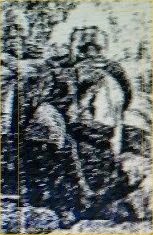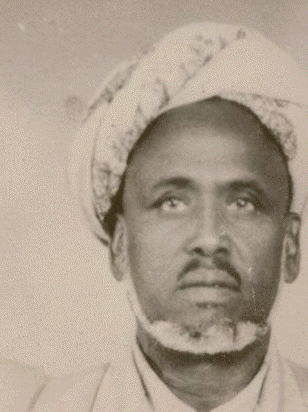|
During
the late 1800’s and early 1900’s, the Gharri people were led by Ali Abdi.
He served the Gharri people during the most difficult and volatile time
in the history of East Africa when they were attacked by their former
allies. Between 1906 and 1907, they were attacked by the Aulihan and the
Marehan from the North and East respectively. Gababa Mahad’s first born
son was killed and 250 of his cattle were looted by the Marehan.
In 1912, the Degodia “Ex Gurre shegats” seized the opportunity and
joined the Aulihana and Marehan fighters in their fighting against the
Gharri people.
Then, two Gharri leaders Ali Abdi and Shaba Alio recruited the Tigray
and deserters from the Ethiopian army to fight back and destroyed the
allied Somali fighters. They also killed Captain Aylmer in 1913 while he
was aiding those allied fighters. Later, these two Gharri leaders were
accused of harboring and sheltering Ethiopian mercenaries and were
arrested and deported from the Gharri district to Nairobi for a year.
Between 1913 and 1914, were another volatile period and the Gharri were
raided from every corner of the Gharri District by the same allied
Somali clans. They lost over 100 of their men. Subsequently Gababa Mahad
assumed a leadership position and defended his people. A year later, Ali
Abdi was released from prison and upon his release, he transferred his
power and appointed Gababa Mahad as the supreme leader of the entire
Gharri tribe. British Mercenaries attempted to enlist him and even paid
him 200 pounds for the loss of 250 of his cattle earlier in 1907, but
that did not persuade him to abandon his people. Beginning from 1913
through 1923, it was a period of instability with sporadic and heavy
fighting between the Gharri and Somali intruders including Degodia,
Marehan, and Aulihan.

 However,
the Gharri people under Gababa Mahad's leadership prevailed
against all odds and became the regional superpower.
Sultan Gababa Mahad was said to be
short and small in stature, but described as "undoubtedly a great
fighter with a great personality, and strong character." He was feared
by his enemies and admired by his people and his allies. The Gharri also
fought against the British occupying forces and the Ethiopians whenever
they felt they were being threatened. However,
the Gharri people under Gababa Mahad's leadership prevailed
against all odds and became the regional superpower.
Sultan Gababa Mahad was said to be
short and small in stature, but described as "undoubtedly a great
fighter with a great personality, and strong character." He was feared
by his enemies and admired by his people and his allies. The Gharri also
fought against the British occupying forces and the Ethiopians whenever
they felt they were being threatened.
In 1923, British mercenaries attempted to collect a tribute by force
from the Gharri. The Gharri supreme leader Gababa Mahad AKA Mohamed
Mahad (Birth Name) strongly objected and rallied against Britain’s
attempts to forcefully collect tributes and conduct registration.
Subsequently fighting ensued in which 9 Gharri warriors were killed and
Gababa Mahad was arrested. He was released later on and upon his
release, he allied with the Ethiopian emperor and moved the Gharri
people to the Ethiopian side of the border where he was welcomed by
Fitaurari Angasu, the Ethiopian officer in charge of armed forces at
that time. The Gharri settled near Qadaduma and

Sultan Gababa began working against British interest and the British
Mercenaries described him (Gababa Mahad) as an “infernal nuisance" He
died in 1935.
Upon his death, his son Hassan Gababa assumed leadership and carried out
the fight against Britain where his father left off. Unlike his father,
Hassan Gababa (Haji Hassan Gababa) did not ally himself with the
Ethiopian emperor, but he did maintain a friendly relationship.
In1936, an Ethiopian officer in charge by the name of Ras Dasta accused
the Gharri people of being collaborators with the Italians and began
harassing them. Soon fighting erupted between the Ethiopians and
Italians. Ras Dasta's army was defeated by General Augustini with the
help of the Gharri militias. The Gharri militias were given a task to
dismantle and break up the civilian administration assembled by Ras
Dasta at Malka Mari. They accomplished it swiftly and quickly. As a
result of the Gharri warrior’s accomplishment, and his leadership, Haji
Hassan Gababa was appointed with the rank of "Fitaurari” in 1936 by the
Italian General Augustini, in recognition of his contribution and
leadership."

He continue working against the British intruder’s taxation without
representation and protected the Gharri people. The British Mercenaries
described him in their report titled "RESUME OF GURRE HISTORY
APPENDEX C PAGE 93 PARAGRAPH #11
“Hassan Gababa remained a thorn
in our flesh".
In 1941, he was captured and arrested by Britain Mercenaries and was
imprisoned at Wajir for two years and then transferred to Marsabit where
he served time until 1945. Upon his release, he contacted Emperor Haile
Selassie and he was welcomed by the Emperor. He retained his title as
Fitaurari and served his people representing Gharri people living in
Ethiopia. He became the members of the Ethiopian parliament and continue
working relentlessly against British interests and blocked every
proposal made by the British Mercenaries including the demarcating of
the Ethiopian- Kenya border line.
He was a stanch supporter of the greater Somalia and played a big role
for their independent until his death in 1962 by Haile Selassie I
|